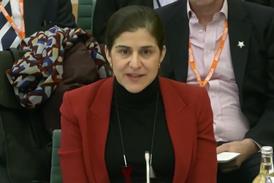For Women Scotland Ltd (Appellant) v The Scottish Ministers (Respondent) [2025] UKSC 16
This case began with For Women Scotland (FWS) bringing judicial review proceedings challenging the definition of ‘woman’ in section 2 of the Gender Representation on Public Boards (Scotland) Act 2018 (GRPBA). By way of background FWS Ltd campaigns for the strengthening of women’s and children’s rights in Scotland.

The PRPBA requires positive action to be taken to redress gender imbalance on public sector boards Scotland. Section 2 defined ‘woman’ as including a transgender woman. FWS made the argument that section 2 went beyond the constraints of the Scottish parliament.
The Court of Session
FWS was unsuccessful before the Outer House of the Court of Session, but it was successful on appeal to the Inner House. As a result of this challenge, Scottish ministers revised statutory guidance which stated that the word ‘woman’ for the purposes of the GRPBA had the same meaning as sections 11 and 212(1) of the Equality Act 2010 (EqA). Furthermore, the guidance stated that where a full gender recognition certificate (GRC) had been issued to a person, that person’s sex was the same as their acquired gender under section 9(1) of the Gender Recognition Act 2004 (GRA).
In response, FWS brought further judicial review proceedings challenging the revised guidance. FWS’s contention has been that the definition of ‘woman’ in the EqA should be taken as being reference to a biological woman.
The Outer House of the Court of Session did not agree. It concluded that there was no conflict between the GRA and the EqA and considered that the EqA makes no reference to ‘biological sex’ and the EqA was drafted with full awareness of the remit of the GRA. In addition, the court held that a transgender individual holding a GRC had protection under the EqA’s protected characteristics of both sex and gender reassignment. FWS was unsuccessful in its appeal to the Inner House of the Court of Session so further appealed to the Supreme Court.
The Supreme Court
FWS was successful in its appeal, with the Supreme Court unanimously determining that the terms ‘woman’, ‘man’ and ‘sex’ in the EqA refer to a person’s biological sex. The conclusion was that an interpretation of ‘certificated sex’ (by way of GRC) under the EqA would lead to incoherence across the statute and its application. Those provisions within the EqA that relate to sex discrimination (pregnancy and maternity, childbirth) could only be interpreted by reference to biological sex. Anything other than a biological meaning would therefore render these provisions unworkable.
The Supreme Court considered that the EqA has to be interpreted both clearly and consistently so those who share a protected characteristic are easily identifiable. In making this clarification, it is easier to ensure practical application of obligations that arise under the EqA. The allowance of a ‘certificated’ interpretation of sex would create tiers within the group that share the protected characteristic of gender reassignment with those who have a GRC being afforded greater rights than those who do not. In addition, there would be no practical way of distinguishing between those who do and do not have a GRC as the question as to possession of a GRC cannot be asked.
The Supreme Court also considered that this ‘certificated’ interpretation of sex would undermine protections for those afforded protection under the protected characteristic of sexual orientation. It would be problematic to have lesbian-only spaces and associations. Under the EqA there are numerous provisions that require a biological interpretation of ‘sex’ in order to work effectively which include, changing rooms, medical services, single sex higher education institutions. The court also considered that further confusion would arise in respect of single sex associations (i.e. rape support groups), women’s charities, the operation of the Public Sector Equality Duty (PSED), the participation of women in sport and the armed forces.
There was a suggestion by the Inner House that there could be an oscillation between biological sex and ‘certificated’ sex across the EqA which was not accepted on the basis that the meaning of the term ‘sex’ must be consistent throughout the Act. For logical reasons, to avoid misinterpretation and misapplication. The lack of definition in respect of ‘sex’ has already led us to this point. A lack of consistency would take us backwards rather than forwards.
The Supreme Court has made it clear that this biological interpretation does not remove protections for trans people who may or may not hold GRC. Trans people are protected from discrimination by virtue of the protected characteristic of gender reassignment and can claim direct discrimination, indirect discrimination and harassment because of either perception or association with their acquired gender. Under section 19 of the EqA, claims of indirect discrimination can be brought by individuals who share the same disadvantage as a protected group, even if they do not strictly fall within it.
The Supreme Court did acknowledge that an anomaly arises in relation to equal pay claims. In you take a sex interpretation on the basis of ‘certificated sex’ a trans woman with a GRC can bring an equal pay claim by identifying a higher-paid male comparator. The same cannot be done by a trans man with a GRC. A biological sex definition would see this right transfer from some trans women to some trans men. The Supreme Court saw this arising from the requirement in an equal pay claim for the identification of an actual comparator of the opposite sex. On applying either definition, ‘certificated’ or biological sex, some trans people would in any event be excluded from using the equal pay route by virtue of the opposite sex comparator requirement. The anomaly did not dictate a different conclusion being reached in respect of the definition of sex.
The clarification at least serves to provide clarity in this area of law, fraught with difficulty. It may not be a decision that suits everyone or be welcomed across the board but is an unequivocal decision from the UK’s highest court. The key takeaway has to be clarification and the need for the EqA to have practical application facilitating the much-needed protection of those groups of people who fall within its defined protected characteristics.
Elizabeth McGlone is a specialist in women’s rights at work and Managing Partner of didlaw, London




























